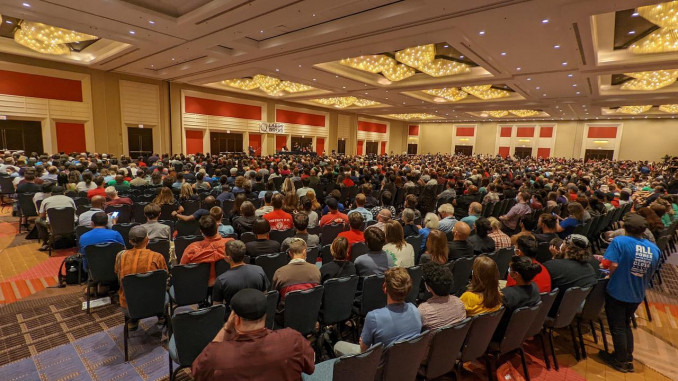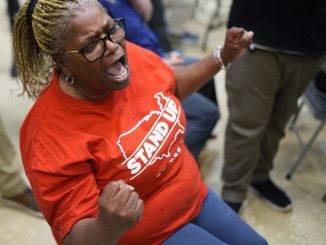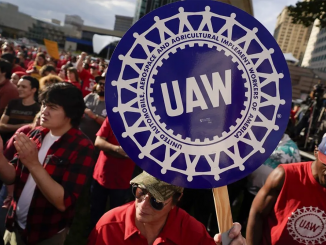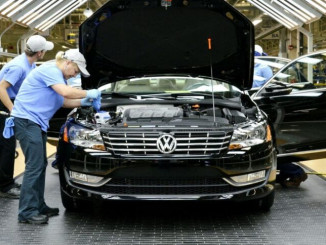
This year’s Labor Notes Conference in Chicago brought a record number of activists and rank and file workers from across the country. According to the organizers, they had to cap registration at 4,000 people in order not to overload the hotel staff.
Labor Notes started in 1979 as a magazine initiated by some members of the International Socialists for rank-and-file unionists, with the aim of education and research, and to promote more democratic and bottom-up organizing efforts in the labor movement. Since its first conference in 1981, the Labor Notes Conference, held every two years, has been a place to get a first-hand glimpse at some of the recent, high profile workers’ struggles and organizing efforts over the past two years, as well as insights into smaller and lesser known struggles and efforts around the country. It has also provided an opportunity for union activists to meet each other.
This year’s conference was noticeably more energized than many of years past.
Recordings of some of the panels are available here.
Because of the pandemic, this was the first Labor Notes Conference since 2018, and this played a role not only in the sheer number of attendees, but in the overall hopeful mood that permeated the conference. For many attendees, not only was this the first large gathering of any type that people had participated in since the pandemic began, but it was also the first conference in this country since the pandemic that focused on left-wing issues and the general class struggle in the U.S. and a few other countries. In addition, many young people attended, partially inspired by organizing efforts from young workers at Starbucks and Amazon. Also, some came from various Democratic Socialists of America (DSA) chapters around the country. All of this helped to contribute to the unmistakable excitement throughout the three-day conference.
Sometimes panelists exaggerated the importance and scale of strikes over the last year, often painting a picture of a new powerful labor movement while ignoring some of the defeats over the same period, and downplaying the enormous challenges faced by most workers, with or without a union. In fact, in 2021 according to the Bureau of Labor Statistics, 80,700 workers were involved in work stoppages involving 1000 or more workers. This was certainly an increase from 2020, which only involved about 27,000 workers. But it was still a decline from the recent high in 2018, which involved 485,000 workers in major work stoppages. That was the year of the wave of teachers’ strikes and some big strikes in healthcare, which contributed to the higher numbers. Nevertheless, the conference was undeniable verification that a broad swath of workers across the country have been engaged in important organizing efforts since the pandemic began.
One workshop featured workers who organized around safety and staffing levels during the pandemic. Between the panelists and the audience, we heard from nurses organizing in hospitals in many states, casino workers, city workers, warehouse workers and more. It was clear that many similar actions took place throughout the pandemic, all across the country, never showing up in any statistics or news reports.
Many panels featured testimonials from young Starbucks workers who organized a union at their stores, most not only organizing for the first time, but at their very first job — some even had to google the word “union” to figure out how to begin. These efforts started out in Buffalo, New York, winning the first union of Starbucks workers in December 2021, and have since spread to over 160 out of the 9,000 stores across the country, clearly driven by largely spontaneous efforts of young workers. For years established unions, including the Service Employees International Union (SEIU, the union those Starbucks workers are joining), have not been interested in expending significant resources to organize workers in isolated fast-food establishments, claiming it was too difficult or required too much work for so few workers. What has changed, however, is not the union leadership, but the self-activity of these workers, which has quickly shown that they don’t need to wait for union organizers to act for them. Starbucks management has, of course, pushed back hard against these efforts, retaliating against organizers — firing some, threatening and harassing others. They have held meetings at other stores aimed at discouraging workers from organizing. But so far, workers’ efforts to unionize have continued.
Several panels highlighted the organizing efforts at Amazon, including workers in the Amazon Labor Union from Staten Island, New York (the first successful unionization effort at any Amazon facility), Amazon workers from Bessemer, Alabama, and workers from Amazonians United, which is not a union but an organizing network of rank-and-file workers that began in an Amazon warehouse in Chicago and spread to workers in other facilities in other states. Some discussions acknowledged the enormous challenges Amazon workers face as they take on the second largest employer in the U.S, with high employee turnover, and within a vast network of highly computerized and networked warehouses and facilities that make it easier for Amazon to reroute shipping from one facility to another if a strike were to break out. The discussions on these panels raised important questions that will need to be addressed as these efforts continue.
At the same time, the Teamsters union at United Parcel Service (UPS), including organizers with Teamsters for a Democratic Union (TDU), spoke of their eagerness to organize Amazon workers into the Teamsters Union, especially as Amazon increasingly tries to takeover more market-share from UPS and FedEx. A couple of panels focused on the Teamsters as they prepare for their national negotiations with UPS next year. Given this environment of increased competition in the packing-and-shipping industry, many of the workers anticipate the need for a nationwide UPS strike next year.
Newly elected Teamsters President Sean O’Brien built up high expectations for winning such a strike when he gave a keynote speech at an evening plenary, riling up the crowd, asking them if they were “ready to take this fight to the streets,” assuring them that “when we mobilize, we strategize, we organize, but most importantly we pulverize.” Many Teamsters in the audience were fired up by this. But rousing halftime speech aside, taking on UPS in this climate with a nationwide strike, if it comes to that, will be a huge battle, ultimately determined not by the speeches of President O’Brien, but by the level of bottom-up organization of the hundreds of thousands of UPS workers, their ability to lead their own struggle, and the degree of support they can build up among workers at other logistics companies and in other industries. And the local and regional organizing efforts of UPS workers over the next year will be decisive in how well prepared they are for a strike.
Some panels featured the important efforts of rank-and-file members of the United Auto Workers (UAW), who formed the Unite All Workers for Democracy (UAWD) in their bottom-up struggle to win control of their union and oust the long-time corrupt leadership of the UAW. Panelists also talked about the urgency to resist the enormous attacks underway in the auto industry as companies increase the production of electric vehicles, opening the door to a significant reduction in the workforce while they also open non-union plants in several states.
There were many more panels and workshops, including John Deere workers in the UAW who recently went on strike, flight attendants organizing to unionize, workers in health care, construction, city and rail transport, the Postal Service, the film industry, education, and many, many more. There was even a panel devoted to workers organizing in China.
But most of all, more than the efforts at unionization, more than the rank-and-file fights against corrupt union bureaucracies, more than the testimonies from recent workers on strike, the most important feature of Labor Notes was the attendees themselves, the workers who came from all parts of this country, hungry to meet each other and learn from one another. In these times, when the working class is under attack, on the economic level as wages fall quickly behind the rising costs of housing, food, gas and other essentials of life, the conference gave a sense of hope that a fight-back is possible.
It also created a sense of class solidarity among people from across the country of different races, ages, industries and backgrounds during a time when there is a systematic attempt to divide us, with attacks through the courts on the rights of women and LQBTQ+ people, attacks on voting rights aimed mainly at Black people, and the openings created for white supremacists and other far-right militia groups. Hopefully this perspective of class unity will be carried home by many of the participants and not swallowed up by the sense of despair that surrounds us and is reinforced by the corporate media.
Because of the consciously apolitical focus of the conference, there was no organized discussion of the central challenge that needs to be addressed that goes beyond the scope of most union activity. And that is the functioning of this system, capitalism, which is based on the exploitation of the working class in the interests of a small capitalist (owning) class. As such, unions are locked in struggles against the normal functioning of this system — low wages, speed-up and short-staffing, unsafe working conditions and occasionally larger questions of discrimination and poverty — but are not organized to meet these challenges head on and comprehensively. So political engagement is generally limited by the union officials to support for Democrats who claim to address the problems confronting the working class but, in the final analysis, are linked to the very system that is the source of the problems. That was evidenced by the ovation given to Bernie Sanders, who shared the podium with O’Brien from the Teamsters and Chris Smalls from the Amazon organizing effort in New York, and who maintains his support for the Democratic party.
Despite this focus, politics were inescapably present. It was not unusual for some panelists or attendees to bring up the need for workers to have independent political action, including a workers party or a labor party. And these comments, although often not pursued, were usually met with enthusiastic agreement.
Overall, this Labor Notes Conference was a much needed reminder of the potential fighting power of the working class, and the fact that despite this period of heightened divisions, there are rank-and-file working class militants fighting in the trenches every day and building bridges among people along the way.




